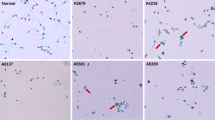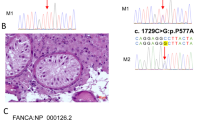Abstract
The FATE gene maps to Xq28 where one case of a translocation breakpoint has been found in an infertile man. Moreover, the FATE promoter contains a putative SF-1-binding site, and FATE has been proposed as representing a target gene of SF-1 in testicular development or germ cell differentiation. This study presents a complete mutational screening of the FATE gene in a random group of 144 infertile males. Four polymorphisms and two mutations were found. Three of the polymorphisms, viz., 741C→T, 905A→C, and 3985C→T, occurred in exon 5 and intron 2 and did not alter the deduced polypeptide. One polymorphism resulted in the conservative amino acid exchange, A10 V, in 16.0% of the patients. This substitution occurred with similar frequencies in the control groups, indicating that the mutation does not affect fertility in men or women. The two mutations caused the non-conservative amino acid substitutions S125R (patient 1) and I34T (patient 2). A family study (patient 1) revealed, however, that S125R was inherited and that a fertile male family member carried the mutation. Patient 2 did not have relevant family members who could be examined. Thus, this study has shown that only 1.4% of infertile men have mutations in the FATE gene, and that some of these mutations do not singly cause infertility. Hence, FATE may not play an important role in the disease-state of infertile men attending fertility clinics. However, FATE mutations cannot be excluded as being a contributing factor in some cases of male infertility.



Similar content being viewed by others
References
Beck-Peccoz P, Romoli R, Persani L (2000) Mutations of LH and FSH receptors. J Endocrinol Invest 23:566–572
Cooke HJ, Hargreave T, Elliott DJ (1998) Understanding the genes involved in spermatogenesis: a progress report. Fertil Steril 69:989–995
Dunnen JT den, Antonarakis SE (2001) Nomenclature for the description of human sequence variations. Hum Genet 109:121–124
Eiberg H, Nielsen LS, Klausen J, Dahlen M, Kristensen M, Bisgaard ML, Moller N, Mohr J (1989) Linkage between serum cholinesterase 2 (CHE2) and gamma-crystallin gene cluster (CRYG): assignment to chromosome 2. Clin Genet 35:313–321
Escalier D (2001) Impact of genetic engineering on the understanding of spermatogenesis. Hum Reprod Update 7:191–210
Foresta C, Ferlin A, Moro E (2000) Deletion and expression analysis of AZFa genes on the human Y chromosome revealed a major role for DBY in male infertility. Hum Mol Genet 9:1161–1169
Foresta C, Moro E, Ferlin A (2001) Y chromosome microdeletions and alterations of spermatogenesis. Endocr Rev 22:226–239
Franco B, Guioli S, Pragliola A, Incerti B, Bardoni B, Tonlorenzi R, Carrozzo R, Maestrini E, Pieretti M, Taillon-Miller P, et al (1991) A gene deleted in Kallmann's syndrome shares homology with neural cell adhesion and axonal path-finding molecules. Nature 353:529–536
Goeminne L (1968) A new probably X-linked inherited syndrome: congenital torticollis, multiple keloids, cryptorchidism and renal dysplasia. Acta Genet Med Gemellol 17:439–467
Gottlieb B, Beitel LK, Lumbroso R, Pinsky L, Trifiro M (1999) Update of the androgen receptor gene mutations database. Hum Mutat 14:103–114
Hackstein JH, Hochstenbach R, Pearson PL (2000) Towards an understanding of the genetics of human male infertility: lessons from flies. Trends Genet 16:565–572
Holyoake AJ, McHugh P, Wu M, O'Carroll S, Benny P, Sin IL, Sin FY (2001) High incidence of single nucleotide substitutions in the mitochondrial genome is associated with poor semen parameters in men. Int J Androl 24:175–182
Huhtaniemi I, Jiang M, Nilsson C, Pettersson K (1999) Mutations and polymorphisms in gonadotropin genes. Mol Cell Endocrinol 151:89–94
Johnson MD (1998) Genetic risks of intracytoplasmic sperm injection in the treatment of male infertility: recommendations for genetic counseling and screening. Fertil Steril 70:397–411
Kent-First M, Muallem A, Shultz J, Pryor J, Roberts K, Nolten W, Meisner L, Chandley A, Gouchy G, Jorgensen L, et al (1999) Defining regions of the Y-chromosome responsible for male infertility and identification of a fourth AZF region (AZFd) by Y-chromosome microdeletion detection. Mol Reprod Dev 53:27–41
Krausz C, Quintana-Murci L, Rajpert-De Meyts E, Jorgensen N, Jobling MA, Rosser ZH, Skakkebaek NE, McElreavey K (2001) Identification of a Y chromosome haplogroup associated with reduced sperm counts. Hum Mol Genet 10:1873–1877
Lavin MF, Concannon P, Gatti RA (1999) Eighth International Workshop on Ataxia-Telangiectasia (ATW8). Cancer Res 59:3845–3849
Layman LC, Cohen DP, Jin M, Xie J, Li Z, Reindollar RH, Bolbolan S, Bick DP, Sherins RR, Duck LW, et al (1998) Mutations in gonadotropin-releasing hormone receptor gene cause hypogonadotropic hypogonadism. Nat Genet 18:14–15
Lerman L, Beldjord C (1998) Comprehensive mutation detection with denaturing gradient gel electrophoresis. In: Cotton RGH, Edkins E, Forrest S (eds) Mutation detection: a practical approach, Oxford University Press, Oxford, pp 35–59
Olesen C, Hansen C, Bendsen E, Byskov AG, Schwinger E, Lopez-Pajares I, Jensen PK, Kristoffersson U, Schubert R, Van Assche E, et al (2001a) Identification of human candidate genes for male infertility by digital differential display. Mol Hum Reprod 7:11–20
Olesen C, Larsen NJ, Byskov AG, Harboe TL, Tommerup N (2001b) Human FATE is a novel X-linked gene expressed in fetal and adult testis. Mol Cell Endocrinol 184:25–32
Povey S, Lovering R, Bruford E, Wright M, Lush M, Wain H (2001) The HUGO Gene Nomenclature Committee (HGNC). Hum Genet 109:678–680
Quack B, Speed RM, Luciani JM, Noel B, Guichaoua M, Chandley AC (1988) Meiotic analysis of two human reciprocal X-autosome translocations. Cytogenet Cell Genet 48:43–47
Reijo R, Lee TY, Salo P, Alagappan R, Brown LG, Rosenberg M, Rozen S, Jaffe T, Straus D, Hovatta O, et al (1995) Diverse spermatogenic defects in humans caused by Y chromosome deletions encompassing a novel RNA-binding protein gene. Nat Genet 10:383–393
Ruiz-Pesini E, Lapena AC, Diez-Sanchez C, Perez-Martos A, Montoya J, Alvarez E, Diaz M, Urries A, Montoro L, Lopez-Perez MJ, et al (2000) Human mtDNA haplogroups associated with high or reduced spermatozoa motility. Am J Hum Genet 67:682–696
Rovio AT, Marchington DR, Donat S, Schuppe HC, Abel J, Fritsche E, Elliott DJ, Laippala P, Ahola AL, McNay D, et al (2001) Mutations at the mitochondrial DNA polymerase (POLG) locus associated with male infertility. Nat Genet 29:261–262
Silahtaroglu A, Hol FA, Jensen PK, Erdel M, Duba HC, Geurds MP, Knoers NV, Mariman EC, Tumer Z, Utermann G, et al (1999) Molecular cytogenetic detection of 9q34 breakpoints associated with nail patella syndrome. Eur J Hum Genet 7:68–76
Singson A (2001) Every sperm is sacred: fertilization in Caenorhabditis elegans. Dev Biol 230:101–109
Stuhrmann M, Dork T (2000) CFTR gene mutations and male infertility. Andrologia 32:71–83
Sun C, Skaletsky H, Birren B, Devon K, Tang Z, Silber S, Oates R, Page DC (1999) An azoospermic man with a de novo point mutation in the Y-chromosomal gene USP9Y. Nat Genet 23:429–432
Vollrath D, Foote S, Hilton A, Brown LG, Beer-Romero P, Bogan JS, Page DC (1992) The human Y chromosome: a 43-interval map based on naturally occurring deletions. Science 258:52–59
Zuffardi O, Fraccaro M (1982) Gene mapping and serendipity: the locus for torticollis, keloids, cryptorchidism and renal dysplasia (31430, McKusick) is at Xq28, distal to the G6PD locus. Hum Genet 62:280–281
Acknowledgements
This work was supported by the The Danish Environmental Research Programme, The Danish Medical Research Council (9700832), Novo Nordisk Foundation, Deutsche Bundesministerium für Forschung und Technologie (01KW99087) and the EU-Commission (BMH4-CT97–2268). Wilhelm Johannsen Centre for Functional Genome Research is established by the Danish National Research Foundation.
Author information
Authors and Affiliations
Corresponding author
Rights and permissions
About this article
Cite this article
Olesen, C., Silber, J., Eiberg, H. et al. Mutational analysis of the human FATE gene in 144 infertile men. Hum Genet 113, 195–201 (2003). https://doi.org/10.1007/s00439-003-0974-9
Received:
Accepted:
Published:
Issue Date:
DOI: https://doi.org/10.1007/s00439-003-0974-9




